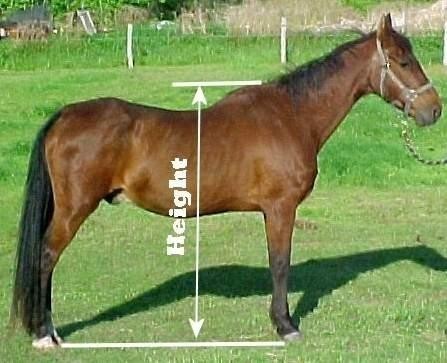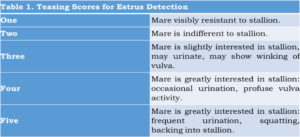Care and Management of Equines (Desi Horses)
Equines are mono gastric herbivorous animals. They can digest a good amount of fibrous feed in caecum, even though they have a simple stomach. Their hoof has no cleft and they are even-toed animals. They are better than bullocks as draught animals. They are well-known for their intelligence and common sense. ‘Check ligaments’ present in the hip joints of horses restricts them to remain standing while sleeping. Horses lie down very rarely as compared to donkeys and mules.
India has some well-defined native breeds of horses which are 7 in no. namely Bhutia, Spiti, Zanskari, Kachchi-Sindhi, Marwari, Kathiawari and Manipuri. Kachchi-Sindhi is the latest registered breed of horse found in the states of Gujarat and Rajasthan.
Kathiawari and Marwari are known for their easy pace, speed, endurance and grace of movement. Sickle-shaped hock joint is found in Kathiawadi breed of horse with common colours of the breed being chestnut, brown, grey and bay.
FEEDING:
Common concentrate feeds given to horses are gram, barley, oats and wheat bran. Other fodders fed to horses are Lucerne, green or hay, grass hays and oats fodder. Natural forage for horses is pasture grass.
Work done by horses can be pided into 3 types i.e. light, medium and heavy. If there are no means to weigh animals, then their approximate body weight may be determined using the formulae as suggested by Y. Dewrst (1975) as follows:
- Body weight (kg) = Chest girth (cm) x 2.7 for light horses.
- Body weight (kg) = Chest girth (cm) x 3.1 for medium- sized horses.
- Body weight (kg) = Chest girth (cm) x 3.5 for heavy horses.
There are different feeding norms for horses performing different types of works given by A.P. Soldatov in practical manual in Animal Husbandry (Russian), Kolos Publishers, Moscow, 1975.
Working equines are ideally fed the whole daily rations which are pided into 4-6 separate meals. Avoiding full feeding immediately before and after work, changing ration composition gradually and regularity in feeding are some of the important points to be kept in mind regarding feeding of horses.
Fodders should be fed to the horses before grains but if fodder is chopped then it can be fed, both the chopped fodder and grains should be mixed and fed together. Grain part of the ration must be fed inpidually. They should be offered 25-40 grams of mineral mixture per day depending on their size and nature of work.
DRINKING WATER:
For at least 20-30 minutes before and after performance of strenuous work, equines must not be provided with water. Ad-libitum quantity of clean and fresh water should be provided at all times. Providing water to the horse before feeding is the general practice. For the horses housed in stables, water troughs are filled thrice a day in summers and twice a day in winters. In the areas with water scarcity, an adult horse must get 40-50 liters of water per day with the amount being higher in summers and for working equines.
- Types of feeds for horses 1) Roughages, (2) Concentrates, and (3) Mixed feeds. Roughages include pasture forages, hays, silages, and by-product feeds that contain a high percentage of
- Concentrates are the energy-rich grains and molasses, the protein and energy-rich supplements and by-product feeds, vitamin supplements, and mineral supplements. Mixed feeds may be either high or low in energy, protein, or fiber; or they may provide “complete” balanced rations.
- Horse feed is mainly in two categories, i.e., concentrated feed and roughage. Horse feed must be balanced with protein, carbohydrate, fat, vitamins, and minerals. The feed must be as bulk as fill the stomach of the
Forages
Under natural conditions, horses spend most of the day grazing. Good quality roughage will provide the majority of a horse’s nutrient requirements. It can also help prevent: Digestive problems such as colic.
Vices associated with boredom. Calcium/phosphorus imbalances.
Feeding systems in Horses
- Stall feeding: Concentrate mixture: twice daily • Foals & Lactating mares: thrice daily Fodder- ad libitum
- Grazing:6-10hrs grazing lands/fallow land/pastures.
- Feeding bags: By horse/mules/donkey/ Tonga owners Offered Hay/concentrate in bags during An imbalance of calcium and phosphorus can lead to severe skeletal abnormalities.
The ideal calcium to phosphorus ratio is the range of 1.2 :1 to 2:1.
Table Diet proportion for horses and expected daily feed consumption.
|
Type of horse |
Percentage of total diet | Percentage of body weight intake | |||
| Roughage | Concentrate | Roughage | Concentrate | Total | |
| Mature, idle | 100 | 0 | 1.5- 2.0 | 0 | 1.5- 2.0 |
| Pregnant mares | 70- 80 | 20- 30 | 1.0- 1.5 | 0.5- 1.0 | 1.5- 2.0 |
| Milking mares | 50- 65 | 35- 50 | 1.0- 2.0 | 0.5- 2.0 | 2.0- 3.0 |
| Performance horses | |||||
| Light work | 65 | 35 | 1.0- 2.0 | 0.5- 1.0 | 1.5- 2.5 |
| Moderate work | 50 | 50 | 1.0- 2.0 | 0.75- 1.5 | 1.75- 2.5 |
| Intense work | 35 | 65 | 0.75- 1.5 | 1.0 -2.0 | 2.0- 3.0 |
| Growing horses | |||||
| Weanling | 30 | 70 | 0.75- 1.0 | 1.25- 3.0 | 2.0- 3.5 |
| Yearling | 40 | 60 | 1.0- 1.5 | 1.0- 2.0 | 2.0- 3.0 |
| 2-year-old | 50- 65 | 35- 50 | 1.0- 1.5 | 1.0- 1.5 | 1.75- 2.5 |
RELATION BETWEEN BODY WEIGHT, WORK LEVEL AND APPETITE
|
||||||||||||||||||||||||||||||||||||||||||
- The amount of dry feed a horse needs to eat every day in order to maintain condition and body This will vary according to the horse’s body weight and the amount of work it is doing.
GUIDE TO THE RATIO OF ROUGHAGE TO CONCENTRATE
- The horse doing light work needs more hay and less energy feed, while the horse doing hard work needs less hay and a greater concentrate feed.
- Horses doing hard work may not be able to eat 3% of their BW, especially if they are fussy eaters, so their appetite should be calculated using 5 % BW and energy-rich feeds used to provide the required energy levels.
| Work level | % Roughage | % Concentrate |
| Resting | 90-100 | 0-10 |
| Light (light completion) | 75-80 | 20-25 |
| Moderate (regular competition. E.g., one-day event horse) | 65-70 | 30-35 |
| Hard (hunting, advanced competition,
e.g., three- day event horse) |
55-65 | 35-45 |
| Intense (racing) | 40-50 | 50-60 |
Dry matter intake-The dry matter intake of horses is 1.5–2.5% of their body weight per day.
| Roughage and concentrate requirements of horses | ||
| Type of work | Feed per 100 kg live weight | |
| Roughage (kg) | Concentrate (kg) | |
| Idle | 1.5 | Nil |
| Light (2 hours/day) | 1.25–1.5 | 0.5–0.75 |
| Medium (2 hours/day) | 1–1.5 | 1.0 |
| Heavy (4 hours/day) | 1.0 | 1.0–1.5 |
Locally available feed ingredients for horses
| Concentrates | Roughages |
| Grains
Maize crushed/grounded Sorghum grounded/crushed Legumes/ protein source Bengal gram(shanagalu) Horse gram(vulavalu)- soaked and boiled By-products/fibre Wheat barn/bhusa Rice barn Oil cakes Grounded cottonseed cake Grounded groundnut cake Oils Mustard oil |
Free grazing Green grasses Jinjiva grass Anjan grass
Stylosanthus hamata Dry Grasses Wheat hay Dried Groundnut plants Dried cowpea plants Paddy straw (not always recommended) Alfa alfa hay Oat hay Wheat hay Haylage Vegetables Beetroot Carrot |
Amount of Feed
- Equine usually consume 1-3% of their body weight per day, Dependent upon age and activity At least 1% of this should be in the form of long-stem roughage.
- Any remaining nutrient requirements should be met with a balanced ration.
- Water/ Dry matter intake – Horses may need 2 to 3 L of water/kg of dry matter intake.
- High salt or excess protein contents – Increase water intake.
- Environmental temperatures – g., need 2 L of water/kg dry feed at -180C, but need 8 L of water/kg dry feed at 380C. Work/exercising – May increase water needs by 20 to 300%.
Creep Ration for 300kg Desi Horse for Maintenance / 1 time.
|
S. No |
Feed ingredients |
Quantity |
| 1. | Maize/sorghum- Crushed/grounded | 1kg |
| 2. | Wheat barn/Rice Barn | 750gm |
| 3. | Bengal gram soaked | 500gm |
| 4. | Horse gram soaked, boiled | 250gm |
| 5. | Chopped Beetroot/carrot | 500gm |
| 6. | Salt -30gm (half handful) | 30gm |
| 7. | Mineral Mixture | 30gm |
| 8. | Himalayan Batisa | 30gm |
| 9. | Total | 3.09kg |
Creep Ration for 400kg Desi Horse for maintenance/ 1 time
|
S. No |
Feed ingredients |
Quantity |
| 1. | Maize/sorghum- Crushed/grounded | 1.25kg |
| 2. | Wheat barn/Rice Barn | 1kg |
| 3. | Bengal gram soaked | 500gm |
| 4. | Horse gram soaked, boiled | 500gm |
| 5. | Chopped Beetroot/carrot | 1kg |
| 6. | Salt -30gm (half handful) | 30gm |
| 7. | Mineral Mixture | 50gm |
| 8. | Himalayan Batisa | 30gm |
| 9. | Total | 4.360kg |
Creep Ration for 400kg Broodmare after 3 months of pregnancy for maintenance –/1 time.
|
S. No |
Feed ingredients |
Quantity |
| 1. | Maize/sorghum- Crushed/grounded | 1.25kg |
| 2. | Wheat barn/Rice Barn | 1kg |
| 3. | Bengal gram soaked | 500gm |
| 4. | Horse gram soaked, boiled | 500gm |
| 5. | Chopped Beetroot/carrot | 1kg |
| 6. | Salt -30gm (half handful) | 30gm |
| 7. | Mineral Mixture | 100gm |
| 8. | Himalayan Batisa | 30gm |
| 9. | Total | 4.360kg |
Note: – Grams can be replaced by grounded oilcakes, soyabean meal. Mix all these feed ingredients with less amount of water and mix thoroughly. Avoid liquid consistency. Advised to feed twice a day morning at 9:30am & evening at 5:30pm after Exercise.
Feed Additives
Mustard oil -50gm per time, twice a day in feed (advised in winters)
Probiotic powders/tablets – Tab Onfeed /rumen Fs bolus – 2boli twice a day for 3 days or Pow Yea sacc100gm for 3 days in feed (advised for at least 3 days in a month and after every deworming).
Liver tonics after every deworming – Livomyn / rivliv / brotone – 30ml twice a day for 1 week.
Deworming Schedule for Adult Horses
| S.no | Month | Drugs in form of Oral paste |
| 1 | January/ February | Pyrako oral paste (pyrantel palmate) |
| 2 | March (summer) | Fenland 10% oral paste or (Fenbendazole) |
| 3 | July (monsoon) | Pyrako oral paste (pyrantel palmate) |
| 4 | October (winter) | Kicktape- equine oral paste or Ashiver plus or Prazimec (Ivermectin & praziquantel) or Abaquantel (Abamectin and praziquantel) |
Note: – Injection for external & internal parasites in Horses – Dectomax – 10ml S/C
Foal Deworming Schedule
Foals have a slightly different deworming schedule compared to adult horses. Here is how the deworming schedule is followed in foals:
|
2-4 months age |
Treat for ascarids with PANACUR® (fenbendazole) foal dose (4.6 mg/lb larvicidal dose), oxibendazole or pyrantel |
|
4-6 months age |
Treat for ascarids and small strongyles with fenbendazole (4.6 mg/lb larvicidal dose), pyrantel or ivermectin |
|
8-10 months age |
Treat for ascarids, small and large strongyles and pinworms (options include fenbendazole larvicidal dose, ivermectin, moxidectin or pyrantel). Treat for tapeworms (options are praziquantel or double- dose pyrantel). Treat for bots (options are ivermectin or moxidectin). |
|
10-12 months age |
fenbendazole larvicidal dose, ivermectin, moxidectin or pyrantel |
Vaccination schedule
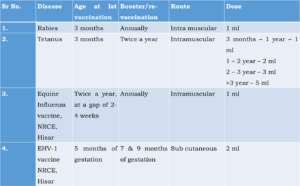
Note – Tetanus Toxoid – Administer at the time of any Injury / wound treatment.
Clavenza – EIV/EHV – Equine Rhinopneumonitis Influenza Vaccine
|
Dose |
Age |
Quantity |
|
1st |
6 months and above |
2ml deep I/M |
| 2nd booster |
28days |
2ml deep I/M |
| 3rd booster |
28days |
2ml deep I/M |
|
Repeat once annually |
||
Signs of health
- The first step in health management is learning to recognize a healthy
- Disease can then be recognized and treated early.
- The horse’s health is determined by evaluating the horse’s general appearance, condition and behavior, and examining specific parts of the horse (such as the hooves and eyes). Also observing its manure and urine and measuring vital signs like heart rate, respiratory rate, and temperature are very important.
Heart Rate
- The normal heart rate of an adult horse at rest is 32 to 48 beats per
|
- This will vary with age of the horse, outside temperature and humidity, exercise, and excitement level.
Respiratory rate
- The normal respiratory rate of an adult horse at rest is 8 – 16 breaths per minute.
- Exercise, air temperature, humidity, fever, distress, pain, and anxiety will increase the respiratory rate.
| Age of the horse | Breaths per minute |
| Newborn | 14 – 15 |
| 1-2 days old | 14 – 15 |
| Up to 2 weeks | 14 – 15 |
| 3-6 months | 14 – 15 |
| 6-12 months | 14 – 15 |
| 1-2 years | 14 – 15 |
| Stallions | 9-10 |
| Geldings | 9-10 |
| Mares | 9-10 |
Temperature
- The normal body temperature of a horse is 99.5 to 5. High outside temperature, exercise, or dehydration can increase this by 2 to 3 degrees.
| Age of the horse | Temperature |
| Newborn | Up to 102.7 |
| 1-2 days old | Up to 102.7 |
| Up to 2 weeks | 99.5-101.3 |
| 3-6 months | 99.5-101.3 |
| 6-12 months | 99.5-101.3 |
| 1-2 years | 99.5-101.3 |
| Stallions | 99.5-100.4 |
| Geldings | 99.5-100.4 |
| Mares | 99.5-100.4 |
General Management practices of horses
- Horse is a very sensitive and agile It can be saved from many diseases by proper maintenance and proper housing.
- Horse shelter should always be open and ventilated and the direction should be such that enough light keeps coming in it.
- The room of the shed should be pucca (made of bricks) and the floor should be solid and rough so that it can be cleaned properly and can be washed with water from time to time, for this the slope of the floor should be such that there is no water Stop and water should also be allowed to drain.
- Bedding materials – paddy straw, husk etc
Stable measurements
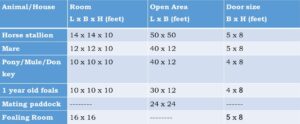
Excercise
- To keep the horses healthy, regular exercise is If the animal has not been exercised for several days, then start with light exercise.
- Exercise can be done in two ways, first by circular/circular ring and second by horse In the circular exercise, the animal is run in a circular/circular ring of 15-20 feet size for 15 minutes clockwise and 15 minutes anti-clockwise.
- It is a matter to keep in mind that immediately after exercise, the animal should be walked for at least 15 minutes.
Hoof Care
- There is a saying in English “No foot no horse”. Hoofs have an important place in horses. Any horse becomes useless when the hoof is damaged, so the hooves should be cleaned and taken care of regularly.
- Regular cleaning of the hooves prevents infections and diseases. Lack of regular cleaning and standing in filth (faeces and urine) and accumulation of dirt in their hooves leads to thrush, hoof abscess and lameness.
- The hoof should be trimmed every 6–8 Consult a veterinarian if any cracks appear in the hoof.
Stallion Management
- Breeding stallions in efficient breeding programs require high maintenance and have certain management Like foal management, care of stallion starts with very early age.
- True to breed good colt having proper confirmation should be selected for future stallion. The proper feeding of selected colt with the objective of optimum growth should be taken.
- The selected colt can be fed with extra milk and creep feed having 18-19 % crude protein for gaining proper body weight and measurement.
- All routine management practices should be followed e., exercise, grooming, hoof care, deworming and vaccination.
- The colt above one-year age should be housed in separate pen having sufficient covered and open area and well-ventilated covered area.
Breeding / covering of mares
- Care of stallions at the time of natural covering / semen collection is also very It should be ensured that mare coming for natural covering or dummy should be free from any type of infection and cleaned properly before mounting by stallion.
- The mare should be properly restrained by applying breeding hobbles to avoid injuries to stallion as well as handler. The prepuce of stallion should be properly washed and cleaned before mounting and also after covering/ semen collection.
- The recommended frequency of semen collection and natural covering is alternate Overuse can cause decreases in sex drive, observed by the stallion’s disinterest in breeding, longer mounting times required before breeding, or lack of ejaculation during breeding.
REPRODUCTIVE MANAGEMENT:
Best breeding season for horses in India and other Asian countries is early spring. A filly must be bred when they attain 3/4th of their mature body weight at about 3 years of age. The gestation period of horse is 10.5-11.5 months. This period depends on the size of the breed. Oestrus period lasts for 4-7 days while the oestrus cycle extends up to 21 days. Signs of oestrus in horses include frequent urination, nickering and swelling and movement of vulva along with biting other animals.
Breeding in mare is done 2-3 days after the appearance of signs of oestrus. One stallion can be used to breed about 30-40 mares depending on its age and number of services practiced per mare with serving usually done five times in a week.
The signs of approaching parturition in mares are presence of wax beads on its teats one to two days before parturition. Relaxation of vulvar lips and a depression of croup muscles on either side of the tail, restlessness, sweating along with lying down and getting up frequently are seen immediately before foaling.
A healthy foal gets up and seeks its mother’s udder within 2-3 hours. Colostrum feeding should be done to the foal during this time. Milk of magnesia can be given to ensure the passing of meconium. Placenta should usually be expelled by the mare in 3 hours. If all the parts of the placenta are not shed by mare in 6 hours, veterinary help must be sought. Both mare and foal should be allowed to walk in a paddock adjacent to the calving box for helping the toning-up of mare’s uterus and developing immunity in the foal.
EQUINE HEALTH:
Due to improper management, horses may be subjected to ailments like sore-feet, colic, pneumonia, fly-blown condition, run-down condition, Influenza or Pink eye, Strangles, Glanders, Farcy, South African Horse Sickness and Tetanus. Vaccination programme should be carried out in horses for these diseases. Providing clean feed and water, maintaining sanitation in the farm and practicing quarantine of newly purchased animals are some other points related to management of equines in a farm.
Hence, it is clear that the afore mentioned points play an essential role in farm management of equines and the farm managers or horse-keepers can keep their horses in a healthy condition keeping these management pre-requisites in mind.
Estimating the Time to Inseminate/ natural covering the broodmare
- Once in the breeding season, a mare will cycle every 21 days until she is bred or enters the anoestrous or non-cyclic seasons.
- Each cycle will have a 5- to 7-day estrus period. During this period, a mare will build follicles on her ovaries, of which one will eventually ovulate a day to two before she goes out of oestrus.
- Highest conception rates are most likely when mares are inseminated 1 or 2 days prior to ovulation up to the time of Insemination outside that time frame reduces the chance of conception. As follicles grow, so will the mare’s acceptance to a stallion’s sexual advances.
Puberty and Gestation
- Age at puberty: Stallions: average15 months (range 12- 24).
- Mares: average 20 months (range 15-24) Breed, genetics and nutrition can affect this greatly.
- Length of Gestation: 336
Sexual behavior
- “Long-day breeders” – mares begin cycling during early spring, are most fertile during the summer and enter “reproductive quiescence” during colder month.
- Oestrus – “heat” lasts three to seven days each 21-23 days during breeding seasons. Signs that a mare is in heat include frequent urination and lifting her tail and “winking” (opening and closing) her vulva.
Grooming
- Grooming is important in maintaining the health and happiness of your • In the wild, horses groom each other. They also roll at will and rub against trees to maintain healthy skin.
- Domesticated horses must rely on humans to provide skin care.
- Grooming, increases the circulation to the skin which then releases the oils that provide lustrous to the horse’s
- Daily grooming also eases the burden of the shedding season by removing the hair coat.
- As well as providing a shiny coat, regular grooming also enables one to notice any cuts, irritations, or fever that can be detected and treated during a thorough grooming session.
Estimating Body Weight
- The girth measurement is taken by placing a tape or thin piece of material (twine) around the horse’s The tape encircles the horse just behind the withers on top and just behind the elbows on the bottom.
- The length of the horse is also considered in some The length is measured from the very front of the shoulder to the very back of the buttocks.
- Once these measurements are taken, the following equation can be used to determine the horse’s weight: (Heart girth squared X the length (inches) /330
Height
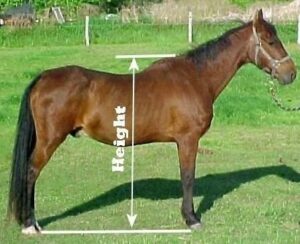
- Measured in hands at the 1 hand=4 inches.
· Pregnancy Diagnosis in Mares
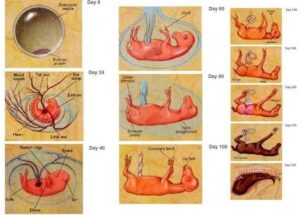
Most Common method of Pregnancy Detection is Rectal palpation.
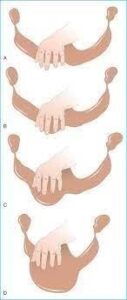
Basic needs to be followed before starting palpation Safety
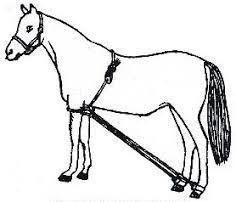
- Personnel Shoe with iron cap Sleeve, tail sleeves.
Mare Restraint
- Travis
- Twitch
- Hobbles
- Sedatives /Tranquilizers- 2%
- Lubrication-Carboxymethylcellulose.
Mare Restraining

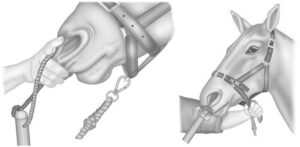
Rectal palpation
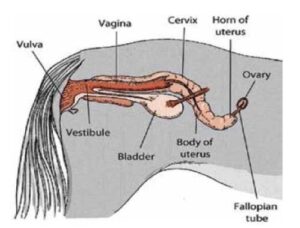
|
Care for new born Foal
- The proper care of new born foal is actually started before its birth because the good health of newborn foal depends on health and body condition of dam.
- Some extra concentrate should be offered to pregnant mares to gain their body condition which helps in milk production for feeding the foal.
- The advanced pregnant mares should be separated from other mare to avoid any type of injury.
- The mare should be shifted to cleaned/disinfected foaling shed near to foaling dates.
- The mare should be closely watched by the mare attendant for foaling. Just after foaling, the nostrils of newborn foals should be cleaned with clean soft cloth for proper breathing and properly examine the foal.
- The umbilical cord should be cut with sterilized blade and tincture iodine may be applied properly to avoid any type of infection from surrounding.
- The newborn foal should be fed first milk/ colostrum as early as possible.
Normal Foaling parameters of a Mare
- Normal gestation 320-365 days.
- Normal birth within 30 min with no manipulation.
- Sitting sternal recumbency within 5 minutes
- Suckle reflex within 20 minutes.
- Standing within 2 hours Nursing within 3 hours.
Neonatal Examination
- A newborn foal is less than one week old. The normal rectal temperature of newborn foal is 99.5- 102 F, which is higher than an adult horse.
- Foal does not regulate body temperature very well for the first few days of life, it is therefore important to provide foal proper protection against the existing outside weather conditions and environment.
- A normal foal passes its first faeces (meconium) a dark brown, firm faecal balls within three hours of birth and continue to pass multiple small piles of miconium.
- All of the meconium should be passed within 24 hours. If a foal show sign of straining a lot, Fleet enema should be given to assist the foal to pass the miconium.
Neonatal Feeding
- Colostrum: Soon after foaling mare produces a thick milk, which is called Colostrum is very important for new born because it is rich in antibodies, protein and calories. These antibodies protect the foal against environmental diseases for the first few months of life.
Foal risk factors
- The following are risk factors in the foal that may lead to problem.
- Foal doesn’t stand or nurse within normal time Lack of suckle or poor affinity for mare cause is Neonatal Maladjustment Syndrome.
- Colic Diarrhoea – foal should not have diarrhoea the first few days of life.
- Abnormal temperature, heart rate and respiration rate v Swollen joints or navel – a sign of septicaemia v Navel doesn’t dry up/stays moist, maggot wound.
Common problems in Newborn foal
- Septicaemia The common cause of newborn illness is septicaemia, which is very serious, and life threatening for a foal. The signs of septicaemia are lethargy, diarrhoea, hypothermia, fever and weakness, cessation of suckle reflex, milk face when a foal bumps the mare’s bag but does not suckle and milk squirts all over the foal’s face.
- Neonatal Maladjustment Syndrome (NMS) Foals with NMS are commonly referred to as a “dummy” foals, wanderers or It is a condition caused by a lack of oxygen to the brain. This occurs secondary to dystocia, and may also be associated with septicaemia or a brain disorder. Signs include lack of the suckle reflex, lack of affinity to the mare, disorientation, and irritability (grinding teeth, sneezing, wandering). If it is severe the foal may seizure or become comatose.
- Ruptured Bladder When the foal is pushed through the birth canal, the bladder may tear internally inside the foal. It is common in colts (90%). The foal appears normal at birth, but depending on the size of the tear, the foal will subsequently show signs of uroperitoneum (urine in the abdomen) between days 1 and 7 of birth. The signs of ruptured bladder are colic, depression, abdominal distension, and urine dribbling.
Management of Orphan foal
- Foal whose dam has not accepted it or has passed away due to one or other reason, such foal can be provided cow’s or goat’s milk as an alternative to mare’s milk, but better results are usually obtained with the use of milk replacers specifically designed to replace the dam’s milk. Goat milk can be used successfully since they are the perfect “foster mother” for most mammalian species. Goat’s milk tends to be more palatable to foals than cow’s milk and causes fewer digestive upset.
- Artificial mare’s milk diets and goat’s milk have also been used successfully to feed orphan foals. Foals should be fed every 1-2 hr for the first 1-2 days of life, then every 2-4 hr for the next 2 week at the rate of 250-500 ml per feeding, using a warmed milk container and an artificial nipple.
- The foal can be weaned off the milk replacer at 3 months of Fresh water should be available to the foal at all times from birth.
Weaning
- Weaning of foals can be done at the age of 4-6 months. v The foals should be separated in different pans from their The care should be taken before separating the foals from their dams, the foals should have habit of eating of feed and fodders well before separating.
- Creep feeding should be adopted for feeding the foals at the age of 5 to 2 months to avoid weaning stress to foals.
- The male and female foals should be housed in separate pens in groups after the age of six months. The special attention should be paid to newly weaned The females can be housed in-group of 10-15 animals depending on the size of paddock. The male horse should be housed in separate pan after the age of one year.
HOUSING:
Horses are loosely housed in inpidual stables. They can also be put in row of stalls that are 1.7 m wide and 3.3 m long.
SHOEING:
Horses should be shoed when they are used for work for the first time, which is by 2-3 years of age. Re-shoeing time depends on the type of work done by the horse.
REFERENCE-ON REQUEST
DR RAMESH KUMAR, ASST. CODT., BSF


